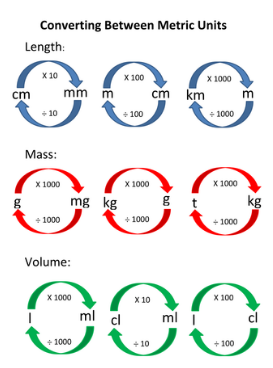The Metric System of Measurement
The Metric system of measurement was created about two hundred years ago by a group of French scientists to simplify measurement.
In the metric system, each of the common kinds of measure — length, weight, capacity — has one basic unit of measure. To measure smaller amounts, divide the basic unit into parts of ten, a hundred, or a thousand, and so on. To measure larger amounts, multiply the basic unit by ten, a hundred, or a thousand, and so on.

Conversions
Sometimes you need to convert from one unit of measure to another similar unit.
Proportions will help you make conversions when working with measurements.

Example 1: Convert 10.25 kilometers to meters.
Notice in the listing above that meter is three places to the right of the prefix kilo. This tells us to move the decimal point three places to the right. The answer is 10,250 meters.
Example 2: Convert 650 mL to daL. [mL is milliliters and daL is decaliters].
Notice in the listing above that the prefix deca is four places to the left of the prefix milli. This tells us to move the decimal point four places to the left. The answer is 0.0650 daL. (Note: dL is deciliters, daL is decaliters.)
Example 3: Convert 750 grams to milligrams.
Notice in the listing above that the prefix milli is three places to the right of gram. This tells us to move the decimal point three places to the right. The answer is 750,000 milligrams.
